
|
Sale 41
Pre-Long Beach Coin and Currency Auction
| Lot |
Photo |
Description |
Realized |
Lot 1300 |
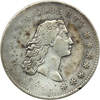 |
1794 Flowing Hair Dollar. Sharpness of EF-40. Some tooling in the hair and marks on the obverse. Signs of light obverse scratches. The date is strong for this year and the eagle has nice details. A newly discovered coin which might be new to the population of this important date. The left side legends on the obverse and the reverse are weakly struck as usual. A pleasing coin and always in demand.
An historic coin, the standard or "Unit" of America's monetary system and the first silver dollar issued at the First Philadelphia Mint. The Mint Act of April 2, 1792 authorized the production of silver dollars of 416 grains weight, with silver content of 371.25 grains, equivalent to .89243 fine. The framers of the Mint Act of 1792, mindful of Alexander Hamilton's Report of January 28, 1791, chose the gross weight of 416 grains and the pure silver content of 371-1/4 grains for the silver dollar, and other silver coins in preparation, to match the average weight of Spanish and Mexican Carolus dollars then in circulation.
The dies for the 1794 dollars are almost certainly the work of Robert Scot, a medallist and die sinker. After the death of Joseph Wright, to Scot fell the task of cutting the dies for coinage, including the 1794 flowing hair dollar. In November 1794, John Smith Gardner was hired as his assistant, but by this time the initial delivery of silver dollars had been accomplished. Probably, Gardner worked on some of the 1795 and later dies.
Known silver dollars dated 1794 are from a single pair of dies and are believed to have been made to the extent of, perhaps, 2,000 coins (Walter H. Breen's estimate), of which 1,758 pieces were considered to be satisfactory delivered by the coiner on October 15, 1794. (The remaining impressions, possibly amounting to 242 coins, rejected as being too weak, probably were kept on hand for later use as planchets. Supporting this theory is the existence of at least one 1795 silver dollar (BB-14) plainly overstruck on a 1794 dollar.)
The obverse and reverse die faces were not set properly in the coining press, with the result that on almost all pieces surviving today the lower left obverse side appears weaker than the upper right obverse side, with corresponding weakness and strength on the opposite areas of the reverse. As the die faces remained out of parallel after having been removed from the press for resurfacing and removal of clash marks, and re-inserted in the press, the cause of the maladjustment must have been that the face of one die (or, less likely, both) was not perpendicular to its shank.
Today, the 1794 dollar is renowned the world over as a great classic American piece of history, not only because it is rare, but because it ranks as the first silver dollar issued by the United States of America. From time immemorial, coin auction sales on a large scale in the 1860s, to the present day, the appearance of a 1794 silver dollar in an auction usually has provided the opportunity for collectors gather together to discuss the coin and its background. Similarly, 1794 dollars have occupied the spotlight in numerous auctions throughout the years (PCGS # 6851) .
Estimated Value $80,000 - 90,000.
View details and enlarged photos
Check results on similar lots
| Realized
$86,250 |
Lot 1301 |
 |
1795 Flowing Hair Dollar. 2 Leaves. . B-1, BB-21. PCGS graded AU-55. Well struck with lovely golden toning. Full detail on Liberty's hair curls unlike on some varieties where even the highest grade pieces lack definition in this key area. Full sharp stars as well, and the rims are impressive for their choiceness and freedom from marks. The fields display a smooth surface with variegated toning whose shades run from light to darker "old silver" color. Here and there, some steel gray iridescence, mainly around Liberty and the stars, but also in several patches on the reverse above, below and to the right of the eagle. The eagle shows outstanding detail for this two-year Flowing hair style dollar. Pop 1; none finer at PCGS for this variety.
Flowing hair in five prominent curls, with a thin faint additional curl below the third curl from the top. The head of Liberty deeply impressed into the die, causing it to be in slightly higher relief than most other varieties of the year. 1795 BB-21 is an affordable variety. It is second only to BB-27 in terms of its availability and perhaps 1,500 to 2,500 exist. However, bear in mind that BB-21 is plentiful only in lower grades, with the average being in the range of Very Fine 20 to 35. Extremely Fine specimens, while scarce, are not rare. About Uncirculated specimens are only occasionally seen.
Estimated Value $20,000 - 23,000.
View details and enlarged photos
| Realized
$18,400 |
Lot 1302 |
 |
1795. Flowing Hair Dollar. . B-5, BB- 27. PCGS graded AU-50 3 Leaves. Lovely toning on both sides with shades of blue and lilac colors. A desirable Red Book variety with three leaves under the wing. Flowing hair in six curls, the 3rd and 4th close together; the 4th has a tiny curved "tail" extending downward, and visible on higher grade pieces. Lowest curl distant from star. A "bar" over 2 mm. long extends diagonally from close to top curl toward point of 5th star. Look for the "bar" near uppermost curl, this is diagnostic. (By contrast, BB-20 has the bar near 4th star.) Wide date, the 1 and 7 farthest apart. First star about as close to 1 as 7 is to 9. Most early die states show striking weakness at the centers. Three leaves under each wing on the reverse; 13 berries, seven on left branch, six on right. This same reverse die was used to strike 1795 BB-25 and BB-26. Pop 3; 1 in 53, and 1 in 58.
Estimated Value $16,000 - 18,000.
View details and enlarged photos
| Realized
$16,388 |
Lot 1303 |
 |
1795. Flowing Hair Dollar. . B-1, BB-21. PCGS graded EF-45 2 Leaves. Evenly toned on both sides. In this interesting variety, the 7 in the date was repunched over an erroneous 1, prompting some to catalogue the variety as 1795 over 1195. The 1 is clearest on early die states. This die bears a resemblance to the die used to coin BB-15; especially with regard to the high position of Liberty's head and the relationship of the hair curl to the first star. Pop 2; 1 in 55 for this variety.
Estimated Value $12,000 - 15,000.
View details and enlarged photos
| Realized
$14,375 |
Lot 1304 |
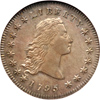 |
1795 Flowing Hair Dollar. 2 leaves beneath each wing. . B-1, BB-21. NGC graded MS-63 PQ Eliasberg. A simply magnificent example! Well struck and beautifully toned in blending shades of violet and gold. Loaded with luster, this is amemorable Premium Quality example for the grade. A lovely specimen, with prooflike surface on obverse and reverse, which traces its pedigree to the world-famous Louis E. Eliasberg, Sr., Collection, 1997, Lot 2170.
The coin is prooflike on both sides and seems to have been struck from lightly polished dies. Some evidence of contact on the obverse and reverse is mostly covered by delightful toning as described above -- creating a coin whose visual appeal and aesthetic qualities will delight the advanced collector of early silver dollars. The strike outstanding as well, with sharp higher detail on the obverse (considering this often-weak variety) including all of Liberty's hair strands being well separated. Further, the reverse is equally well defined in all areas except for the very highest part of the eagle. There is some flatness at that particular spot, but due to striking as equivalent wear would have removed the piece from its present grade category.
Numismatic sources reveal there to be a number of pieces of the BB-21 variety in Mint State, of which the present coin will certainly stand its ground against all worthy competitors. Grading was and always will be a matter of opinion, and while the present piece is certainly of exceptional quality, it is not possible to evaluate carefully the offerings of decades or generations ago, unless they can be traced and compared side-by-side today. The present piece challenges the Condition Census and may lie well within it. Pop 1; 2 in 65 (PCGS # 6853) .
Estimated Value $125,000 - 150,000.
View details and enlarged photos
Check results on similar lots
| Unsold |
Lot 1305 |
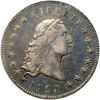 |
1795 Flowing Hair Dollar. 2 leaves beneath each wing. NGC graded EF-45. Attractive bluish-grey antique toning on both sides. Struck on an excellent planchet, quite clean and free from adjustment and other impairments. Most collectors, just after they arrive at an understanding of this early series of silver coins, discover (often to their dismay) that choice, uncleaned specimens are the exception not the rule. That is why we want to emphasize the loveliness and strict originality of this handsome flowing hair 1795 dollar. A bidder hoping to score a bargain price will be disappointed; on the contrary, a strong bid is needed to land this fine catch for your collection.
BB-20 uses Obverse 5, the same so-called Close Date obverse seen on BB-19, the Head of 1795 style. Flowing hair in six prominent curls with the lowest curl pierced and separated by the innermost point of star 1. The obverse is paired to Reverse G (in the Bowers reference) with two leaves under each wing. For die verification, a leaf ends directly below center of first S in STATES and another leaf ends just under left corner of upright of E in STATES. The wreath is delicate, leaves small, berries large. 19 berries arranged nine left, 10 right. Paired berries opposite I in UNITED, opposite A in STATES, under leaf below O in OF, and opposite I in AMERICA, on both inside and outside of wreath (PCGS # 6853) .
Estimated Value $12,000 - 14,000.
View details and enlarged photos
Check results on similar lots
| Unsold |
Lot 1306 |
 |
1795 Flowing Hair Dollar. 3 leaves beneath each wing. NGC graded AU-53 BB-27, B-5. Some luster visable. An very attractive example of this first style of U.S. silver dollar, among the best in its class. The luster is evident on both sides, and both surfaces are pleasing light silver-gray in color, hiding nothing, but fortunately there is nothing to hide. The coin is outstanding for the grade.
A brief review of America's early silver dollars will put this flowing hair 1795 in its proper perspective. The mintages were small throughout 1794-1803 because little demand existed domestically for silver dollars. The first United States Mint struck coins to order, for the most part. That is what the "free coinage" of silver and gold meant in those halcyon days. Bankers and others deposited silver or gold with the Mint, which the Mint's workers turned into the desired coinage and then delivered to the owners of the precious metals.
Those depositing silver with the Mint in those first years has a preference for the more convenient half dollars to the silver dollars, ordering more of the smaller denomination than the larger. As best as we can understand, the silver was too large for small transactions but too small for convenient transportation or storage of large sums. Many 1794-1803 silver dollars were melted.
Striking silver dollars that were only going to be melted (or exported) was wasteful of the Mint's production capacity. Production of this denomination ceased after 1803, possibly under the orders of President Jefferson. The halt in production for the silver dollar proved more than temporary. It wouldn't be struck for circulation again until 1840, at the second Philadelphia Mint. Pop 6; 11 finer. (PCGS # 6852) .
Estimated Value $16,000 - 18,000.
View details and enlarged photos
Check results on similar lots
| Unsold |
Lot 1307 |
 |
1795 Flowing Hair Dollar. 3 leaves beneath each wing. . BB-27. NGC graded AU-53. Untoned with some luster present. A sparkling and lustrous coin, one with a satiny beauty that includes fully defined design features for the variety (the topmost hair waves show little detail on these, even in the finest condition), plus a burst of varying light silver gray shades over both sides. The reverse has three leaves under each wing, 13 berries of which seven are on left branch, six on the right. Two berries under first T in STATES, one on inside and one on outside of wreath. All specimens of BB-27 examined by Bolender showed a fine die crack from end of left stem downward, as here. This reverse die also struck BB-25 and BB-26. Pop 7; 9 finer for variety. (PCGS # 6852) .
Estimated Value $16,000 - 18,000.
View details and enlarged photos
Check results on similar lots
| Realized
$16,100 |
Lot 1308 |
 |
1795 Flowing Hair Dollar. 3 leaves beneath each wing. . BB-27, B-5. NGC graded EF-45. Light greyish-violet with slight iridescense. Possibly dipped at some time in the past, the color is now uniformly pale dove gray with accents of color around the head and eagle and providing contrast to the date, stars, and letters in the legends on both sides. Clear rims and equally smooth, blemish free surfaces attest to its careful storage and handling all these many years. There is a small raised dash line behind Liberty's first head curl. This is a diagnostic feature of BB-27, found on all specimens and the die's "signature" as it were. It is believed that the die maker, holding his engraving tool during the hair strengthening process to finish making the die, let his hand slip, causing this slight graze line in the die. The result is a raised line on the struck coins. Desirable Flowing Hair silver dollar variety with 3 leaves under each wing. Pop 10; 21 finer. (PCGS # 6852) .
Estimated Value $12,000 - 13,000.
View details and enlarged photos
Check results on similar lots
| Unsold |
Lot 1309 |
 |
1795 Flowing Hair Dollar. 3 leaves beneath each wing. . BB-18, B-7, Silver Plug. NGC graded VF-35. Medium violet-grey with lighter highlights. Pleasing problem-free planchet with the central "silver plug" visible at all angles. A smoothly preserved example has excellent rims on both sides with all of the "eye-appeal" and character embodied by the strict Very Fine 35 state of preservation. Pop 2 in VF; 5 finer. (PCGS # 6852) .
Estimated Value $9,000 - 10,000.
View details and enlarged photos
Check results on similar lots
| Realized
$10,350 |
Lot 1310 |
 |
1795 Flowing Hair Dollar. 3 leaves beneath each wing. Sharpness of VF-30. BB-27, B-5. Signs of old cleaning, still quite pleasing and now toned an antique pinkish-grey in the fields, nicely offsetting the lighter gray of the main devices, stars and letters. The fields are smooth, free of marks, as are the rims. The head of Liberty on this variety is set in higher relief than other flowing hair varieties of 1795.
Estimated Value $2,500 - 2,800.
View details and enlarged photos
| Realized
$3,450 |
Lot 1311 |
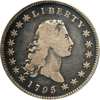 |
1795 Flowing Hair Dollar. 3 leaves beneath each wing. . B-7, BB-18. PCGS graded Fine-12. Pop 1; 1 graded in VF at PCGS. A total of 2 graded for this variety. Lightly toned (PCGS # 6852) .
Estimated Value $2,200 - 2,400.
View details and enlarged photos
Check results on similar lots
| Realized
$4,140 |
Lot 1312 |
 |
1795. Draped Bust Dollar. . B-14, BB-51. PCGS graded AU-55 Off Centered. Well struck with nice even toning on both sides. The stars are all full; Liberty and eagle display excellent detail as well. And all problem-free! Draped bust of Liberty facing right, the hair tied up in a ribbon at back. The bust was not centered in the die work, being positioned to the left. The highest wave of the hair is under the B of Liberty. Lowest curl is distant from 1 in 1795. Star 1 touches curl.
This obverse was used to strike 1795 BB-51 only. It is combined with Bowers' Reverse K which is the initial small eagle type, differently styled than on any of the preceding varieties of 1795. Small Letters in legend. Eagle stands on clouds. Wreath is composed of a palm branch (right) and olive branch (left), the latter with seven berries. A short, prominent die scratch extends up to left from tip of right, inside leaf below the left wing. Berry under A of STATES; a quick way to identify this reverse.
(This reverse die is one of the most remarkable in all of American numismatics, and was paired with obverse dies bearing four different dates: 1795 BB-51; 1796 BB-62, BB-63, BB-66; 1797 BB-72; and 1798 BB-81.) Pop 1; 2 in 58 only 3 graded at PCGS for this variety.
Estimated Value $16,000 - 18,000.
View details and enlarged photos
| Realized
$18,600 |
Lot 1313 |
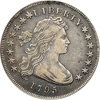 |
1795 Draped Bust Dollar. Centered bust. PCGS graded EF-40. Well struck with plenty of detail for the grade. Mostly smooth planchet with some faint adjustsment marks about a portion of the obverse rims. Attractive antique grey with lighter highlights. 1795 BB-51 is one of the more abundant varieties of the 1795 year and runs third only to the BB-27 and BB-21 flowing hair varieties. Almost certainly, well over 1,000 specimens exist. Bowers, in his estimable volume on the series of bust silver dollars, estimates the number to be between 1,400 and 2,000. Desirable for being the first year with draped bust Liberty and small eagle reverse. Pop 1; 4 finer for the variety (PCGS # 6858) .
Estimated Value $7,500 - 8,000.
View details and enlarged photos
Check results on similar lots
| Unsold |
Lot 1314 |
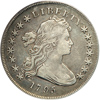 |
1795 Draped Bust Dollar. Centered bust. PCGS graded VF-20. A total of 6 coins graded at PCGS of this variety. Light grey toning on both sides contrasting nicely with the lighter gray "rubbed silver" patina of the high points, the ideal combination and "look" on a fresh, uncleaned early draped bust silver dollar. BB-52 has the head of Liberty centered, with a small die break in the hair to the right of the hair ribbon (PCGS # 6858) .
Estimated Value $3,000 - 3,400.
View details and enlarged photos
Check results on similar lots
| Realized
$4,485 |
Lot 1315 |
 |
1796 Draped Bust Dollar. . B-2, BB-63. PCGS graded VF-20 Sm Dt Sm Lt. Mostly untoned. Small wide date; all of the figures of date evenly spaced wide apart. 6 leans to the left. Combined with the reverse of 1795 BB-51 which has small letters in legend. The eagle stands on clouds. Wreath is composed of a palm branch (right) and olive branch (left), the latter with seven berries. A short, prominent die scratch extends up to left from tip of right, inside leaf below left wing. As few as 175 to 300 specimens exist of 1796 BB-63. Pop 2; only 2 graded at PCGS for this variety.
Estimated Value $6,000 - 6,500.
View details and enlarged photos
| Realized
$4,888 |
Lot 1316 |
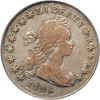 |
1796 Draped Bust Dollar. Small date, small letters. PCGS graded VF-25. BB-63. We note an old scratch in the obverse field before Liberty's mouth. Attractive delicate pinkish-grey toning that deepens just slightly around the devices on both sides.
On this variety, there is a small wide date; all of the figures of date evenly spaced wide apart. 6 leans to the left. Highest wave of hair under serif at left bottom of E; second highest wave under upright of R. End of hair tress touches only one (the innermost) point of star 1. This reverse first used on 1795 BB-51. Small eagle, small letters in legend. Eagle stands on clouds. Wreath is composed of a palm branch (right) and olive branch (left), the latter with seven berries. A short, prominent die scratch extends up to left from tip of right, inside leaf below (observer's) left wing. Berry under A of STA TES; a quick way to identify this reverse. Weakly detailed at center (PCGS # 6859) .
Estimated Value $4,500 - 5,000.
View details and enlarged photos
Check results on similar lots
| Realized
$5,463 |
Lot 1317 |
 |
1796 Draped Bust Dollar. Large date, small letters. . B-5, BB- 65. NGC graded EF-40. Light grey toning on both sides with excellent detail throughout the main design. Choice surfaces. A very attractive specimen of the year and variety. On this BB-65 variety, the "large" size of the date is not immediately obvious, but upon study, the digits are indeed slightly larger, and are in the numeral size used the following year, 1797. The 6 in date plainly shows it was double punched; this is visible at the underside of the top of the 6 and the upper inside of the bottom loop. Stars at right are very closely spaced and touch or nearly touch their neighboring stars. Highest wave of hair is below upright of E and is very indistinct, probably due to very light relapping. Pop 6; 13 finer (PCGS # 6861) .
The estimated mintage of 72,920 1796-dated dollars (of various die varieties combined, each of the draped bust, small eagle type) is less than that of the estimated mintage of 110,000 draped bust dollars coined with the date 1795. The Mint experienced severe difficulties in 1796, including an annual yellow fever epidemic. Coinage was anything but easy. On June 1, 1796, Tennessee was admitted to the Union as the 16th state. While other denominations reflected this, 16 stars were not used on silver dollars until 1797, which suggests that obverse dies for 1796-dated dollars were made prior to June. The number of dies employed to create 1796-dated dollars is as follows: 1796 obverses, 4; reverses, 4 (including one left over from 1795).
Estimated Value $7,000 - 7,500.
View details and enlarged photos
Check results on similar lots
| Unsold |
Lot 1318 |
 |
1797 Draped Bust Dollar. . B-1, BB-73. PCGS graded EF-45 9x7 Lg Lt. Well struck and lightly toned. A few small marks in the field before Liberty. BB-73 shares an obverse with BB-72, with 16 stars, arranged 9 to the left and 7 to the right. Highest wave of hair, below upright of E, is lightly defined, probably due to insufficient depth of punching of the draped bust motif into the die. Prominent lump in field below star 9. The reverse with large letters style; 8 berries in left branch. Leaf ends under center of upright of E in STATES. Usually seen with broad borders, a feature more noticeable on the obverse, where the denticles are prominently featured. Together with BB-71, the BB-73 is one of the two most accessible varieties of the year, with possibly over 1,000 1797 BB-73 in existence. One of the more important Red Book "Types". Pop 1; 4 finer at PCGS for this variety.
Estimated Value $7,500 - 8,000.
View details and enlarged photos
| Realized
$9,200 |
Lot 1319 |
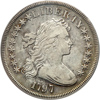 |
1797 Draped Bust Dollar. 9 stars left, 7 right, small letters. PCGS graded VF-30. Lightly toned. Rare variety. Of all 1797 varieties, the BB-72 is at once the rarest, best known, and most sought after of the draped bust, small eagle series (1795-98). This issue occupies its own niche in numismatic literature, where it has been showcased as a rarity for the better part of a hundred years. Doubtless, it is the best known die variety of the 1795-98 years combined. Indeed, it may well be the most famous variety after 1794 and before 1804 in the view of Bowers, who published a large volume on this series of coins. "While various cataloguers over the years have ascribed great rarity to 1797 BB-72," cautions Bowers, "I believe that about 200 to 300 exist today …"
He fails to mention, that of this estimate, many (most?) are low-quality or problem coins of one sort or another. That this handsome specimen, with its natural colors, surface preservation second to none, and objectively superior aesthetics, is so sensational, we assign it to a league all its own (PCGS # 6866) .
Estimated Value $12,000 - 14,000.
View details and enlarged photos
Check results on similar lots
| Unsold |
Lot 1320 |
 |
1797 Draped Bust Dollar. 10 stars left, 6 right. PCGS graded EF-45 BB-71. Nicely toned on both sides. 16 stars, only six at right facing bust. A die dot close to the bottom right of the second digit makes the date read 17.97; the last 7 is high. The star arrangement of 10 stars to the left and six to the right is unique in the dollar series. A well struck example given the low-technology period in which it was made. All the right pieces come together here: high grade, solid aesthetic appeal, rarity (the draped bust, small eagle silver dollars are among the most difficult Types to obtain). A ringing bell isn't required to call your attention to it. Pop 27; 31 finer for this date. BB-71; B-3 (PCGS # 6865) .
According to the Bowers encyclopedia: "In 1797 the number of stars on the silver dollar was increased to 16. The coinage is said by government reports to be the lowest of any year from 1795 to 1803, although now it is believed that the numbers given are incorrect. I believe that most or all of the mintage of 7,776 coins reported for the calendar year may have been of earlier dates, and that most coins struck from dies dated 1797 were actually made in early 1798."
Estimated Value $7,500 - 8,000.
View details and enlarged photos
Check results on similar lots
| Unsold |
Lot 1321 |
 |
1797 Draped Bust Dollar. 10 stars left, 6 right. . B-3, BB-71. NGC graded EF-40. Adjustment marks on the obverse, otherwise smooth surfaces throughout with a nod to excellent preservation much nicer than average. Lightly toned. Pop 8; 34 finer (PCGS # 6865) .
In 1797 the number of stars on the silver dollar was increased to 16. The coinage is said by government reports to be the lowest of any year from 1795 to 1803, although now it is believed that the numbers given are incorrect. In 1797, production problems continued at the Mint. Sporadic coinage runs for silver dollars occurred in February, late May to late June, and in August. The Mint was closed from late August to late November, due to a yellow fever outbreak. Thus, the mintage for the calendar year was very small.
Estimated Value $7,000 - 7,500.
View details and enlarged photos
Check results on similar lots
| Unsold |
Lot 1322 |
 |
1798 Draped Bust Dollar. Large eagle, 5 vertical stripes in shield. NGC graded EF-40. Attractive uniform natural greyish-violet toning on both sides. A pleasing looking coin struck on a problem-free planchet. BB-101. Wide date, the 8 just touching bust. Date is over 11.5 mm. across at bottom widest part. Upper star on left very close to L, and upper star on right is near Y. Second star ray points slightly right of denticle. The denticles to left of date are irregular. Obverse die used to strike 1798 BB-101 only. Combined with Reverse F: Large Letters, 5 lines in each vertical shield element. BB-101 is from an later state than BB-96 with which it shares this reverse. On the BB-101 variety some berries appear without stems. Only 10 arrows, the two sticks seen on BB-96 having now been removed. The reverse die was used to coin BB-96 dollars, reground and used to coin BB-101.
1798 BB-101 is a rare variety. Probably about 70 to 120 are known, according to the Bowers guide to early dollars, "most of which are well circulated. The average grade of F-19 is one of just a few to dip below the VF category. An AU or Mint State coin, if such could be found, would be regarded as a landmark item." Pop 1; 6 finer, 3 in 45, 1 in 50; 2 in 53 (PCGS # 6874) .
Estimated Value $3,300 - 3,600.
View details and enlarged photos
Check results on similar lots
| Realized
$3,565 |
Lot 1323 |
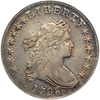 |
1798 Draped Bust Dollar. Large eagle, close date. . BB-105, B-23. NGC graded AU-55. Luser is still evident about the devices. Quite attractive featuring natural light greyish-violet toning. A common die variety. Usually lightly struck at the centers according to the Bowers encyclopedia of silver dollars. The obverse die was used to strike 1798 BB-104 (early state) and BB-105 (early and late states). Reverse H has several die flaws, one between ST, another between TE, another at right of E in STATES. There is a curved die flaw above third upper right star on reverse. Five small berries in the branch, the two above closest together. Arc star pattern; star ray points to center of B in PLURIBUS. 13 arrows. This reverse die was used to strike 1798 BB-105 (late state) and BB-106 (early state). Pop 2; 3 finer; 1 in 58; 1 in 61; 1 in 65. (PCGS # 6873) .
Estimated Value $9,000 - 10,000.
View details and enlarged photos
Check results on similar lots
| Unsold |
Lot 1324 |
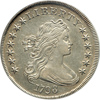 |
1798 Draped Bust Dollar. Large eagle, wide date, 13 arrows. ANACS graded AU-53. A well struck example. Light even steel toning and problem-free (PCGS # 6877) .
Estimated Value $5,500 - 6,000.
View details and enlarged photos
Check results on similar lots
| Unsold |
Lot 1325 |
 |
1798 Draped Bust Dollar. Large eagle, wide date, 13 arrows. . B-14, BB-122. NGC graded VF-30. Nice original antique toning on both sides. A problem-free coin. Medium wide date. BB-122 closely resembles BB-124, and is distinguishable by the fact that it has the 8 closer to the bust than does BB-124, while the 11th and 12th stars on BB-122 are much closer together than on BB-124. Obverse die used to strike 1798 BB-122 only. Reverse S, with line star pattern: Claw touches A in AMERICA; the only 1798 reverse with this feature. Somewhere in the range of 350 to 550 1798 BB-122 dollars are believed to exist. The variety is rarely seen above Extremely Fine and may be unknown in Mint State. The distribution of available specimens is weighted toward the low end of the Very Fine category (PCGS # 6877) .
Estimated Value $2,000 - 2,200.
View details and enlarged photos
Check results on similar lots
| Realized
$2,070 |
Lot 1326 |
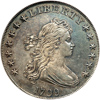 |
1799 Draped Bust Dollar. . B-8, BB-165, Rarity 3. NGC graded AU-58. Boldly struck and well toned with alternating shades of gray and blue. There is a mark in the field below UNUM on the reverse.
Liberty with open mouth on this variety. First star is slightly farther from curl than last star is from bust, or about 2 mm. from curl. The Reverse M die has several flaws inside and to right top of final S in STATES which is diagnostic. Die used to strike 1799 BB-165 only. Pop 73; 58 finer (PCGS # 6878) .
Estimated Value $9,000 - 10,000.
View details and enlarged photos
Check results on similar lots
| Realized
$9,775 |
Lot 1327 |
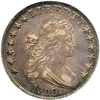 |
1799 Draped Bust Dollar. . B-9, BB-166. . BB-166, B-9. NGC graded AU-58. A pleasing problem free strike with luster appearing about the obverse. All attractively toned in shades of antique grey and violet. 1799 BB-166 and BB-163 are the most affordable varieties of the year. It seems likely that about 1,000 to 1,800 of BB-166 are known. The population of is distributed in a bell curve, with few extremely worn ones, some Very Good, more in Fine grade, a cluster at Very Fine, fewer Extremely Fine, etc. This lovely and lustrous About Uncirculated 58 specimen is head and shoulders above the competition. That is why we expect it to draw numerous bids and, upon closing the final bid, nods of acknowledgement to the successful buyer (PCGS # 6878) .
Estimated Value $9,000 - 10,000.
View details and enlarged photos
Check results on similar lots
| Realized
$10,063 |
Lot 1328 |
 |
1799/8 Draped Bust Dollar. . B-3, BB-141. PCGS graded AU-50 15 Stars. Nicely toned. Last 9 punched over previous 8, and definitive as such; the only overdate die of the year. Last 9 of date very close to bust. Stars very close together. Letters of LIBERTY are widely spaced. Die flaws at left base of E, under RT, and above R. This obverse is mated on BB-141 with a 15-star reverse; this too is definitive, although to the uninitiated the two extra stars are easy to miss. They are almost lost in cloud 1 and cloud 8, and just the points show. In terms of availability among overdates of this year, 1799/8 BB-141 is the most plentiful, edging out BB-142 by a wide margin. About 700 to 1,200 are known today of this variety. Pop 1; 3 finer at PCGS for this variety.
Estimated Value $7,000 - 8,000.
View details and enlarged photos
| Realized
$7,705 |
Lot 1329 |
 |
1799 Draped Bust Dollar. . B-23, BB-159. PCGS graded AU-53 8x5 Stars. Nicely toned. Only 5 stars to right of bust on this Red Book variety. The obverse stars are arranged eight to the left and five to the right; the only 1799 with this peculiar arrangement. The reason for this configuration is not known. It may have been a mistake, or the engraver may have punched the eight stars on the left after just having cut a die for a 1799 $10 gold coin (all of which have stars set 8x5 this year). He would then have been compelled to finish the die using only five stars on the right. BB-159 is the only time this die was used.
In a year with relatively little to offer in the way of notable die varieties, the 1799 BB-159 is a favorite with collectors due to its distinctive character. Most are in low grades through Very Fine. There is no dispute that About Uncirculated examples are popular pieces. Pop 1; 1 in 55. Only 3 graded for this variety.
Estimated Value $6,000 - 6,500.
View details and enlarged photos
| Realized
$7,360 |
Lot 1330 |
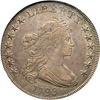 |
1799 Draped Bust Dollar. . BB-155, B-19. NGC graded AU-53. Nice even toning on both sides. A high degree of residual luster distinguishes the satiny silver gray surfaces from others of the AU53 grade which are less pulsating even though in technically similar state of preservation. Collectors familiar with the series will recognize this difference at once. 1799 BB-155 is one of the key rarities of the year. It may be that as few as 70 to 110 exist today. Nevertheless, as of 2007, there are more coins available than there are specialized collectors desiring to pay a significant premium for them; thus, specimens sell for little more than "type" prices. View this, then, as an advantage for anyone wishing to get involved in early dollars. Most examples of the 1799 BB-155 dollar are in lower grades through Extremely Fine. Only a few AU and Mint State coins exist. Ideal for a Type set. Pop 2; 1 in AU55; 1 in AU58.
Estimated Value $6,000 - 6,500.
View details and enlarged photos
| Realized
$5,463 |
Lot 1331 |
 |
1799 Draped Bust Dollar. ANACS graded VF-20. Uniform greyish-violet toning on both sides. Some scattered marks here and there, a few in the field before the chin. Housed in the new style ANACS clear view holder. BB-164 (PCGS # 6878) .
Estimated Value $1,600 - 1,700.
View details and enlarged photos
Check results on similar lots
| Realized
$2,100 |
Lot 1332 |
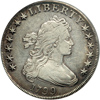 |
1799 Draped Bust Dollar. . B-12, BB-160. Mostly untoned. Only 4 graded of this variety at PCGS (PCGS # 6878) .
Estimated Value $1,600 - 1,700.
View details and enlarged photos
Check results on similar lots
| Realized
$2,185 |
Lot 1333 |
 |
1799 Draped Bust Dollar. Sharpness of EF-40 BB-106. Small dent at 5 o' clock on the obverse. Nicely toned with residual luster in the areas around the main devices and legends (PCGS # 6878) .
Estimated Value $1,000 - 1,200.
View details and enlarged photos
Check results on similar lots
| Realized
$1,323 |
Lot 1334 |
 |
1799 Draped Bust Dollar. Irregular date, 13 stars on reverse. EF-45 BB-160. A well struck example with excellent surfaces that exhibit light golden toning. This obverse closely resembles both BB-165 and BB-166, but the first star of BB-160 is much farther from curl, slightly over 2.5 mm. Versus only about 2 mm. in BB-166. On the right, stars 11-12-13 are closer together than are the others. Obverse die used to strike 1799 BB-160 only. On the reverse, there are no berries. U in UNITED defective at upper left part, which is cut off due to defective punch. Point of star touches point of lower part of eagle's beak; ray points to left serif at left side of U in PLURIBUS. Star under cloud 1 is noticeably smaller than any other. Far right edge of A is over junction of clouds 3 and 4. A in AMERICA rests on 4th feather (PCGS # 6880) .
Estimated Value $3,400 - 3,600.
View details and enlarged photos
Check results on similar lots
| Unsold |
Lot 1335 |
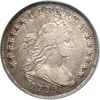 |
1799 Draped Bust Dollar. 9 over 8. 15 stars on reverse. PCGS graded EF-45. Nicely struck on a problem-free planchet and lightly toned. Pop 24; 57 finer (PCGS # 6883) .
Estimated Value $4,500 - 5,000.
View details and enlarged photos
Check results on similar lots
| Unsold |
Lot 1336 |
 |
1800 Draped Bust Dollar. . B-10, BB-190. PCGS graded EF-40 Wide Date. Nice light even toning. Wide date on BB-190, 00 very wide apart, and the 8 is too low. The 8th star is close to Y, last star not quite so near bust. The reverse is from same die as BB-189, but now with light die crack from leaf through C to border. Among dollars of this date, 1800 BB-190 is one of the most affordable issues. As many as 600 to 1,100 are believed to exist with this EF40 being a pleasing, representative example. Pop 1; 4 finer at PCGS .
Estimated Value $3,500 - 3,800.
View details and enlarged photos
| Realized
$4,600 |
Lot 1337 |
 |
1800. Bust Dollar. PCGS VF 35. . B-11, BB-191. PCGS graded VF-35. AMERICAI variety. Only 2 graded at PCGS for the variety. Nicely toned specimen. A few light hairlines. AMERICAI variety (one of two AMERICAI varieties, the other, which shares this reverse, is BB-192). After the word AMERICA, an almost vertical line, a stray mark (apparently, not a die crack), perhaps from a punch or from a stray piece of metal during the die making process, appears more or less like an "I" added. There are no serifs to the stray mark, and it takes some imagination to call it an I, but the nomenclature has been with us for a long time, and "AMERICAI" it is. Nowhere else in the silver dollar series has a stray die mark done so much for a coin's reputation in the eyes of collectors. Other characteristics: Star enters eagle's mouth; point of lower part of beak touches star lightly below point. Upper part of beak does not quite touch. Pop 1; 1 finer in 50.
Estimated Value $2,500 - 2,700.
View details and enlarged photos
| Unsold |
Lot 1338 |
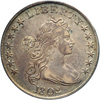 |
1802 Draped Bust Dollar. . B-6, BB-241. PCGS graded AU-50 PQ. Nice even toning. A high degree of luster spins smoothly underneath the satin, evenly toned surfaces of this handsome early silver dollar. The strike is crisp in most areas, which makes it a must-have for any Type set buyer, with outstanding stars and hair curls on the obverse, plus equally sharp detail on the eagle and shield. Pop 1; 1 in 53, none finer at PCGS.
Estimated Value $6,500 - 7,000.
View details and enlarged photos
| Unsold |
Lot 1339 |
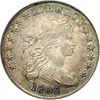 |
1802 Draped Bust Dollar. Narrow date. PCGS graded AU-53. Attractive uniform light pastel toning on both sides. No problems worth mentioning. A high degree of original luster springs to life beneath the toned highlights. Everywhere we peer with an all-seeing magnifying lens we find sharp detail. The obverse, the reverse, both sides display much more detail than can be found on just about any other 1802 dollar of this variety and grade level. We almost expect the coin's buyer to have a special box made in which to keep his purchase, it is that classy looking.
BB-242 with T in LIBERTY perfect, normal denticulated borders. (BB-241, the only other normal date 1802 other than the restrike Proof, has a defective right base on the T in LIBERTY). Pop 22; 62 finer (PCGS # 6895) .
Estimated Value $6,500 - 7,000.
View details and enlarged photos
Check results on similar lots
| Realized
$11,500 |
Lot 1340 |
 |
1802, 2 over 1. Wide date NCS XF Details. . BB-234. Obverse graffiti and improperly cleaned. Lighter silver-gray centers deepen to the look of "old silver" at the margins and around the devices (PCGS # 6899) .
Estimated Value $1,000 - 1,100.
View details and enlarged photos
Check results on similar lots
| Realized
$1,500 |
Lot 1341 |
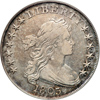 |
1803. Bust Dollar PCGS EF 40 Large 3. . B-6, BB-255. Naturally toned over choice surfaces. Thick top to 3 in date. Star 13 close to bust. Reverse same as that used on 1801 BB-212 and several others (a long-lived die). It has been estimated that about 1,250 to 2,000 specimens are known of 1803 BB-255. About as plentiful as 1802 BB-241, and, like it, the 1803 BB-255 dominates its year -- accounting for more coins than all other die varieties of 1803 combined. Pop 1; 7 finer for the variety .
Estimated Value $3,500 - 3,800.
View details and enlarged photos
| Realized
$3,910 |
Lot 1342 |
 |
1803 Draped Bust Dollar. Small 3. NGC graded AU-53. Untoned. Softly struck in areas of both sides but desirable nonetheless due to its choice surfaces and overall damage-free originality. Pop 1; 3 finer, 1 in 58, 1 in 61, 1 in 64 (PCGS # 6900) .
Final mintage: 1803-dated dollars were the last produced during the early 19th century. By this time it had become profitable to export or melt newly-minted dollars, and the continued production of them would have been an exercise in futility. Had it not been for this factor, coinage might have continued for many years. The existence of so many worn early dollars of the 1794-1803 years is evidence of their success in domestic channels of commerce (other dollar-sized coins, notably the Spanish-American issues, circulated very effectively as well). After the end of the draped bust obverse, heraldic eagle reverse coinage, the center of attention focused on the half dollar as the largest circulating silver coin, a situation the denomination filled for the better part of three decades.
Estimated Value $7,000 - 7,500.
View details and enlarged photos
Check results on similar lots
| Unsold |
Lot 1343 |
 |
1848 Liberty Seated Dollar. NGC graded Proof 64. Well struck and needle sharp. The mirror surfaces are overlaid with mottled greyish and violet toning. Probably less than a dozen made. Pop 6; 1 in 66, 1 in 67 (PCGS # 6989) .
Estimated Value $28,000 - 30,000.
View details and enlarged photos
Check results on similar lots
| Realized
$32,200 |
Lot 1344 |
 |
1860-O Liberty Seated Dollar. MS-60 Plus. Untoned with a few light hairlines (PCGS # 6950) .
Estimated Value $700 - 750.
View details and enlarged photos
Check results on similar lots
| Realized
$1,035 |
Lot 1345 |
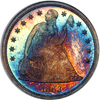 |
1863 Liberty Seated Dime. NGC graded Proof 66. A spectacular gem proof specimen! Exquisite multi-color iridescent toning on both sides. Only 460 proofs made. Worthy of a premium bid. Pop 6, 5 finer (PCGS # 4756) .
Estimated Value $15,000 - 17,000.
View details and enlarged photos
Check results on similar lots
| Realized
$23,000 |
Lot 1346 |
 |
1868 Liberty Seated Dollar. PCGS graded Proof 63. Pleasing even midnight blue toning on the obverse while the reverse features a blending of midnight blue and lighter shades of violet. Only 600 proofs made. Pop 45; 90 finer (PCGS # 7016) .
Estimated Value $2,500 - 2,700.
View details and enlarged photos
Check results on similar lots
| Realized
$2,990 |
Lot 1347 |
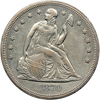 |
1870-CC Liberty Seated Dollar. AU-50. Light hairlines. A well struck and still lustrous light gray specimen of this first year from the Carson mint, a coin featuring relatively smooth surfaces on both sides. Somewhat finer than typically seen for the date, even with the cleaning, with excellent design details at the center on both sides. Only 11,758 coins struck (PCGS # 6964) .
The 1870-CC silver dollar was the first issue produced at the Carson City Mint, which quickly focused on the half dollar denomination. Halves were favored by silver depositors since they received greater face value in return (the tenor of the half dollar having been reduced in 1853 while the silver dollar was left unchanged. Few silver dollars were struck, yet this mintage is still larger than the combined mintage of the 1871-CC, 1872-CC, and 1873-CC seated dollars. It is for this reason, collectors prefer to select an 1870-CC for their holdings is only a single CC-mint representative is desired.
Estimated Value $2,000 - 2,300.
View details and enlarged photos
Check results on similar lots
| Unsold |
Lot 1348 |
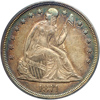 |
1871 Liberty Seated Dollar. PCGS graded AU-55. Attractive old antique toning deepens toward the rims to lovely iridescent steel blue (PCGS # 6966) .
Estimated Value $600 - 650.
View details and enlarged photos
Check results on similar lots
| Realized
$1,265 |
Lot 1349 |
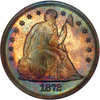 |
1872 Liberty Seated Dollar. PCGS graded Proof 65 PQ. A spectacular gem with gorgeous rainbow toning on both sides! An unbelievably beautiful array of colors on this gem with sizzling mirrors beneath the color. Devices are nicely frosted, but not so that it has gotten the "cameo" designation. The reverse and obverse centers play host to needle-sharp originality always appreciated by the stronger buyers of Proof seated coins. In short, a lovely coin, a marvel of preservation, one that certainly more than meets the qualifications for the grade. Only 950 Proofs were minted. This beauty is a Premium Quality coin. PCGS reports 19; 1 in PR-66 (PCGS # 7020) .
Estimated Value $10,000 - 11,000.
View details and enlarged photos
Check results on similar lots
| Realized
$14,950 |
|
|